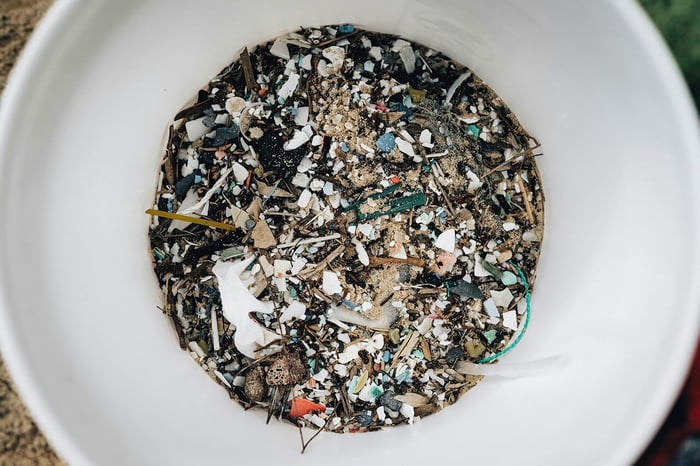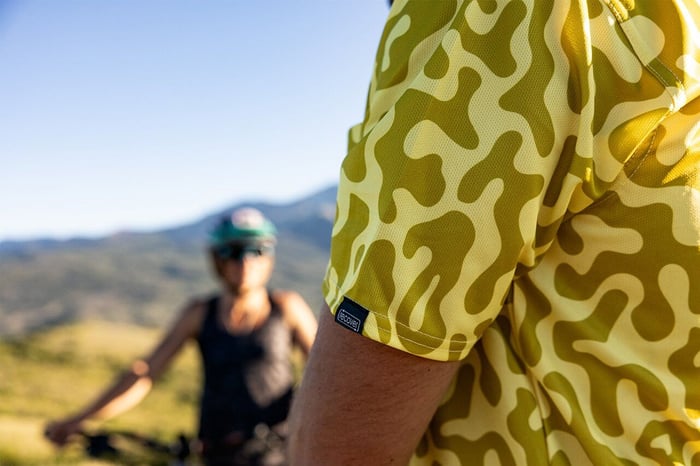Since the 1960s, the widespread use of plastics in consumer markets has led to their integration into nearly every aspect of our lives. As time progresses, we are also developing a deeper understanding of the consequences of our plastic consumption habits, particularly the issue of plastic waste.
Our efforts, such as using recycled materials, like post-consumer plastic bottles, for new products and supporting pollution reduction initiatives through 4ocean, help to address the impact of overall plastic pollution. However, the full impact of microplastic pollution remains largely unknown and continues to be an area of growing concern.
Here’s what we know so far about microplastics:
What are microplastics?
According to the NOAA, microplastics are small plastic pieces less than five millimeters long (or about the size of a pencil eraser).
What is the source of microplastics?
Microplastics can either enter the environment at the micro-sized scale (primary microplastics) or fragment from larger pieces of plastic already in the environment (secondary microplastics).
According to the Ocean Conservancy, the most common types of microplastics are:
Microfibers: Originating from clothing, home fabrics, personal care products, fishing nets and rope, cigarette filters, and other fibrous materials
Tire-wear particles: Particles created by the friction between tires and roads
Nurdles: Also known as pre-production plastic pellets, form the foundation of many plastic products we use in our daily lives
Films: Come from thin, flexible plastics such as grocery or chip bags
Microbeads: Manufactured plastic beads less than 1mm in size that have been used as exfoliators in personal care products such as face wash and toothpaste
Paint Particles: Created when surfaces shed paint flakes or are sandblasted
Fragments: Formed when larger plastics break into small pieces.
What are the impacts of microplastics?
Microplastic pollution is incredibly difficult to clean up due to the small size of the particles. Additionally, as the size of the plastic pollution decreases, its bioavailability increases, which means it can impact more species.
Research has shown that microplastics have traveled up the food chain, all the way to human ingestion. As of 2023, about 1,300 marine species have been found to ingest plastics, and as of 2019, it was estimated that human adults can take in up to 121,000 microplastic particles per year through air, food, and drinks.
Ingestion of microplastics in animals has been linked to various adverse health effects such as decreased food intake, stunted growth, negative behavioral changes, lowered reproduction, and DNA and cell damage. Human digestion of microplastics has also been documented and can potentially result in chronic toxicity, carcinogenicity, and developmental toxicity.
Additionally, microplastic pollution has been shown to affect oxygen-producing organisms like bacteria and phytoplankton found in the ocean, negatively impacting their oxygen production and reproduction.
What about microplastic pollution, textiles, and Recover?
At Recover, we pride ourselves on working to address the challenge of plastic pollution. While working to reduce plastic consumption is the best step in addressing the plastic crisis, there is unfortunately a large amount of plastic waste that already exists.
Through our efforts, such as using high-quality recycled polyester made from materials like single-use plastic bottles for our products, as well as supporting water pollution clean-up initiatives through 4ocean and local riverkeeper organizations, we can help to address the impacts of overall plastic pollution.
We are also committed to using non-synthetic, sustainable fiber options, such as recycled cotton and organic cotton, across our product lines to ensure we have natural-based fiber options. Recycled cotton is currently the most sustainable material available, as it helps to reduce landfill waste and uses fewer resources than conventional cotton production. It saves on water, energy, land, and pesticides, while also reducing greenhouse gas emissions.
By utilizing recycled cotton and blending it with high-quality recycled polyester yarn, we are able to reduce the overall impact and microfiber plastic pollution from our products.
However, we recognize that using synthetic textiles, recycled or not, can still contribute to microplastic pollution in our waterways through the release of microfibers. Some of the main source of microplastic pollution from textiles is experienced during the use phase and the end-of-life phase.
Here are some practices that help mitigate the entry of microplastics from apparel into our environment:
Read the care label: Follow best practices for laundering and drying of textiles and apparel products displayed on the garment tag’s care instructions.
Reduce laundering: As garments are laundered more and more over time, they can release more microfibers. By limiting washes, we can limit the friction the apparel experiences, limiting the amount of microfibers being released.
Utilizing filtration devices for washing machines: Using a microfiber protection bag like GUPPYFRIEND or a microfiber laundry filter like the Planet Care Microfiber filter can reduce microfiber pollution from laundering by up to 98%. Cora Ball also makes a laundry ball that helps prevent and collect microfibers during laundering.
Use a front-loading washing machine: Studies have found that top-loading washing machines release significantly more microfibers compared to front-loading models.
Hang drying and lint prevention: Consider hang drying your clothing after laundering, as drying clothes in a dryer releases additional microfibers into the environment. If using a dryer, consider also opting for dryer balls or an outdoor lint trap.
Reuse and recycle materials: When your apparel reaches the end of its life, consider reusing the material for something new, or recycling through our 360 Closed Loop Program, which helps to divert textile waste from landfills and prevent the degradation of textile materials in our environment.
Opt for high-quality synthetic materials: With continued development in synthetic fibers, like features such as longer fiber lengths and coatings that reduce shedding, fabrics can be manufactured in a way that limits microfiber pollution. If purchasing synthetic apparel, consider buying high-quality garments, like those from Recover.
The effects of microplastic pollution and the strategies to best prevent it remain an emerging field of study. While there isn’t yet a widespread understanding of this issue, we are continuing to develop our products in a way that takes microplastics into account and addresses the overall plastic pollution crisis. As we continue to learn, we are also dedicated to sharing known and effective practices that can help reduce the release of microplastics into the environment.






